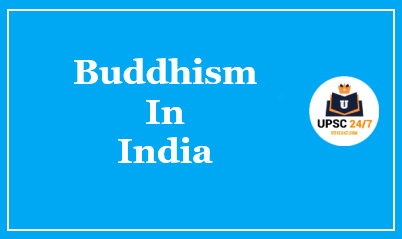Buddhism UPSC | Origin | Teachings | Buddhist Councils | Literature – In 6th Century There Were Some Strict Social Religious Norms Which Were Well Established And Practised By The People . But Due to These Socio Religious Norms There Was Exploitation Of Some group Or Some Class Of People . Due To These All Norms Demand Of New Religion Was Raised . This Led To Emergence Of Buddhism And Jainism In India And Other Part Of World Also Witness This . In this Article We Will Will Discuss About Every Thing Which Is Related to Buddhism And Can Be Asked In Exam . We will Also Cover Latest Current Affairs Of This Topic .

Some Important Facts About Buddha For UPSC Exam | Buddhism UPSC
- Buddhism was founded by Gautama Buddha.
- Buddha was born as Prince Siddhartha at Lumbini near Kapilavastu (in present Nepal) in 566 BC.
- He was the son of Suddhodhana and Mahamaya.
- Suddhodhana was the chief of the Sakya clan. Due to this, Buddha was also known as ‘Sakyamuni’.
- His mother died either giving birth to him or after seven days. Siddhartha was brought up by his maternal aunt, Prajapati Gautami. This gave him the name ‘Gautama’.
- He was married to Yashodhara and had a son, Rahula.
- He left his home at the age of 29 to become an ascetic. This event is called Mahabhishkramana.
- The idea of renunciation occurred to the Buddha after he saw four different states of man – sick man, old man, corpse and ascetic.
- Buddha wandered for seven years and at the age of 35 attained enlightenment at Uruvela while meditating under a Peepal tree (Fig Tree/ Ficus Religiosa) on the banks of the river Niranjana. This tree came to be known as ‘Bodhi tree’ and the place became Bodh Gaya (in Bihar).
- He gave his first sermon at Sarnath near Varanasi. This event is called Dharmachakra Pravartana/ Dhammachakkappavattana.
- He died in 483 BC under a Sal tree in Kushinagar (in UP). This event is called the Mahaparinirvana.
- The term ‘Buddha’ means ‘enlightened one’.
- Important contemporaries of Buddha were Mahavira Jaina, Kings Prasenjit, Bimbisara and Ajatasatru.
- He died at the age of 80 in 483 BCE at a place called Kushinagara a town in UP. The event is known as Mahaparinibban.
Tenets of Buddhism | Basic Beliefs and Practices | Buddhism UPSC
- Buddha asked his followers to avoid the two extremes of indulgence in worldly pleasure and the practice of strict abstinence and asceticism.
- He ascribed instead the ‘Madhyam Marg’ or the middle path which was to be followed.
- According to him everyone was responsible for their own happiness in life, stressing upon the individualistic component of Buddhism.
- Dukkha and its extinction are central to the Buddha’s doctrine. Suffering is not limited to the actual pain but also to the potential to experience these things.
- The essence of Buddhism is the attainment of enlightenment. It points to a way of life that avoids self-indulgence and self-denial. There is no supreme god or deity in Buddhism.
- The ultimate goal of Buddha’s teaching was the attainment of nibbana which was not a place but an experience, and could be attained in this life.
The main teachings of Buddhism are encapsulated in the basic concept of four noble truths or ariya-sachchani and eightfold path or astangika marg.
Four noble truths:
-
- Suffering (dukkha) is the essence of the world.
- Every suffering has a cause – Samudya.
- Suffering could be extinguished – Nirodha.
- It can be achieved by following the Atthanga Magga (Eight Fold Path).
Eight Fold Paths: the path consists of various interconnected activities related to knowledge, conduct, and meditative practices.
-
- Right view
- Right intention
- Right speech
- Right action
- Right livelihood
- Right mindfulness
- Right effort
- Right concentration
|
Buddha also established code of conduct both for the monastic order and the laymen to follow which are also known as the Five Precepts or Pancasil and refrain from them.
- Violence
- Stealing
- Sexual misconduct
- Lying or gossip
- Taking intoxicating substances .
Major Buddhist Texts UPSC | Buddhism UPSC
Prakrit and Pali were the languages spoken by Indians in the post-Vedic period. Prakrit is a generic term for any language which is different from the standard one i.e. Sanskrit. Pali is archaic Prakrit and a combination of various dialects. Lord Buddha gave his sermons in Pali and hence the early Buddhist literature developed in Pali.
Buddhist Literature available in India can be divided into two prominent categories,
- Prakrit and Pali Literature
- Sanskrit Literature
Tripitaka
The most important among the early Buddhist literature is the Tripitaka. Also known as the Threefold Basket, they include – Vinaya Pitaka, Sutta Pitaka, and Abhidhamma Pitaka. These, in turn, contain several books in them. Apart from them, there are many works which also form a part of the canonical literature, like the Tripitaka.
| Vinaya Pitaka |
- Contains the rules of the Order of Buddhist monks which must be observed for achieving purity of conduct.
- Hence, it is also called the Book of Discipline.
- It, in turn, has three books viz., Suttavibhanga, Khandhaka, and Parivara.
|
| Suttavibhanga |
Also known as the Patimokkha Sutta, contains the rules for fully ordained monks called bhikkhus (Maha Vibhanga) and fully ordained nuns called bhikkhunis (Bhikkhuni Vibhanga). |
| Khandhakas |
- Contain regulations on the course of life in the monastic order and have two sections – the Mahavagga and the Cullavagga.
- The former deals with the awakening of the Buddha and his great disciples while the latter deals with the First and the Second Buddhist Councils, the establishment of a community of Buddhist nuns.
|
| Parivara |
- Believed to be composed by a Ceylonese monk, it’s a manual of instruction about the contents of the Vinaya Pitaka.
|
| Sutta Pitaka |
- Lays down the principles of religion.
- It is divided into five groups called the Nikayas.
- These include Digha, Majjhima, Samyutta, Anguttara, and Khuddaka.
|
| Digha Nikaya |
- The Long Collection, comprises 34 long Suttas.
- Of these, the Mahaparinibbana Sutta is the most important as it provides information on the last few days of the Buddha.
|
| Majjhima Nikaya |
- It is a collection of middle-sized reports on instructions and it contains 152 suttas.
|
| Samyutta Nikaya |
- It is a collection of instructions divided into groups and contains 56 groups of the suttas.
|
| Anguttara Nikaya |
- It is the gradual or “by one limb more” collection where the first chapter deals with things which occur only once, the second chapter deals with things which occur twice and so on.
|
| Khadduka Nikaya |
- It is a collection of little pieces i.e. it contains texts of a diverse character which are scattered literary works.
|
| Abhidhamma Pitaka |
- It is the latest of the Tripitaka.
- It contains expositions on the scholastic philosophy which include discourses on various subjects, such as ethics, psychology, theories of knowledge and metaphysical problems.
|
Khuddaka Nikaya | UPSC
Khuddaka Nikaya includes some prominent literary works such as – Full List Of Literature Given Below
| Khuddakapatha |
- A prayer book, it’s foremost among the pieces included in the Khuddaka Nikaya
|
| Dhammapada |
- Contains 423 gnomic stanzas which are very popular among the people.
|
| Udana |
- A collection of Impassionate utterances of the Buddha. It contains the popular story of “Blind Men and Elephant”.
|
| Itivuttaka |
- Means “thus has been said”, comprises maxims spoken by the Buddha to his disciples.
|
| Suttanipata |
- It is a collection of archaic literary pieces.
|
| Vimanavatthu |
- Describes the grandeur of celestial palaces where the gods live
|
| Petavatthu |
- Describes the miserable existence of the departed souls who have to expiate for their sins.
|
| The Thera and the Theai |
- gathas are the songs of monks and nuns which are very appealing due to their lyric quality.
|
Canonical literature of Buddhism | Buddhism UPSC
| Jatakas |
- Give an account of the former existences of the Buddha.
- They contain 547 poems.
- These are mentioned in the Khuddaka Nikaya.
- They are very close to the folklore literature.
- In Sanskrit, they are known as the Jatakamala.
- In Khmer, they are known as cietak, and in Chinese, they are known as Sadok.
|
| Niddesa or Mahaniddesa |
- A commentary on the two chapters of the Suttanipata.
|
| Patisambhidamagga |
- Deals with knowledge and can be considered a part of the Abhidhamma literature in view of its contents.
|
| Buddhavamsa |
- It is a legend in verse. It contains a narration of the life and activities of the 24 Buddhas who preceded Gautama.
|
| Apadanas |
- They are the holy legends. They contain a description of the activities of young monks and nuns who have attained the position of Arhats.
|
| Cariyapitaka |
- It is a selection of 35 metrical Jatakas.
- It reveals that in each of his previous existences Bodhisattva acquired the ten paramitas (perfections).
|
Non – Canonical Literature Of Buddhism
Apart from the canonical literature, there was a long series of non-canonical literature in Pali. Some of them include,
| Milindapanha |
- which means “questions of Milinda”.
- It contains a dialogue between Milinda who was the Graeco-Bactrian King Menander and the monk Nagasena over some problems of Buddhism.
- It was originally written in Sanskrit.
|
| Mahavamsa |
- Deals with the royal dynasties of Indian subcontinent including Sri Lanka.
- It is known as the world’s longest unbroken historical accounts.
|
| Dipavamsa |
- Deals with the arrival of the Buddha’s teachings and preachers in Sri Lanka.
|
Sanskrit Literature Of Buddhism
Sanskrit literature became prominent in Buddhism with the rise of Mahayana Buddhism. However, some of the Sanskritic works were produced by the Hinayana school as well.
| Mahavastu |
- Believed to be the most important work of the Hinayana school.
- It is a collection of stories and different parts of it were composed in different periods.
- However, by including the details of miracles and earlier lives of the Buddha, it also displays some Mahayanic thought.
|
| Lalitavistara |
- Believed to be one of the most sacred of Mahayanic texts.
- It deals with the biography of the Buddha.
|
| Buddhacharita |
- Written by Asvaghosa, it’s an epic style Sanskrit work.
- It tells the life history of Gautama Buddha.
|
| Mahavibhasa Sastra |
- written by Vasumitra,
- it’s also linked to the Samkhya and Vaisheshikha philosophies of Hinduism, apart from Buddhism.
|
| Udanavarga |
- It contains verses which are attributable to the Buddha and his disciples.
|
Besides the above literature, there also exists Vajrayana Buddhist literature which mainly forms a part of canonical Tibetan-Buddhism. They are known as the Buddhist Tantras. They are subdivided into
- Kriya Tantras – focus on ritual actions
- Charya Tantras – centred on the worship of Buddha Vairocana (celestial Buddha)
- Yoga Tantras – they too focus on Vairocana
- Anuttara Tantras – focus on mental transformation rather than on ritual actions.
Buddhist Councils UPSC
Buddhist Councils marked important turning points in the early Buddhism. These councils resulted in sectarian clashes and the eventual Great Schism that resulted in the two major schools, Theravada and Mahayana. In total, 4 major Buddhist councils were convened: Full Details of The All Councils Click On This Link .
| First Council |
- It was held soon after the Mahaparinirvan of the Buddha, around 483 BC under the patronage of King Ajatshatru and was presided by Mahakasyapa, a monk.
- The council was held in the Sattapani cave at Rajgriha.
- The council was held with the purpose of preserving Buddha’s teachings (Sutta) and rules for disciples. During this council, the teachings of Buddha were divided into three Pitakas.
|
| Second Council |
- It was held in Vaishali, a village in Bihar under the patronage of the king Kalasoka in 383 BC. It was presided by Sabakami.
|
| Third Council |
- It was held in 250 BC in Patliputra under the patronage of Ashoka and was presided by Moggaliputta Tissa.
|
| Fourth Council |
- It was held in 72 AD at Kundalvana, Kashmir.
- It was presided by Vasumitra, while Asvaghosa was his deputy under the patronage of King Kanishka of Kushan Empire.
- Buddhism was divided into two sects namely Mahayan and Hinayan.
|
Schools of Buddhism UPSC
| Mahayana |
- It is one of the two main schools of Buddhism.
- The term Mahayana is a Sanskrit word which literally means “Great Vehicle”.
- It believes in the heavenliness of Buddha and Idol worship of Buddha and Bodhisattvas embodying Buddha Nature.
- It originated in northern India and Kashmir and then spread east into Central Asia, East Asia and some areas of Southeast Asia.
- Buddhist schools embedded in China, Korea, Tibet and Japan belong to the Mahayana tradition.
|
| Hinayana |
- Literally Lesser vehicle, also known as Abandoned Vehicle or Defective vehicle. It believes in the original teaching of Buddha or Doctrine of elders.
- It does not believe in Idol worship and tries to attain individual salvation through self discipline and meditation.
- Theravada is a Hinayana sect.
|
| Theravada |
- It is the most ancient branch of extant Buddhism today.
- It remains closest to the original teachings of the Buddha.
- Theravada Buddhism developed in Sri Lanka and subsequently spread to the rest of Southeast Asia. It is the dominant form of religion in Cambodia, Laos, Myanmar, Sri Lanka, and Thailand.
|
| Vajrayana |
- Vajrayana means “The Vehicle of the Thunderbolt”, also known as Tantric Buddhism.
- This Buddhist school developed in India around 900 CE.
- It is grounded on esoteric elements and very complex set of rituals compared with the rest of the Buddhist schools.
|
| Zen |
- It is a school of Mahayana Buddhism that originated in China during the Tang dynasty as the Chan school of Chinese Buddhism in and later developed into various schools.
- It spread to Japan in 7th century C.E.
- Meditation is the most distinctive feature of this Buddhist tradition.
|







